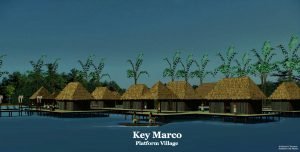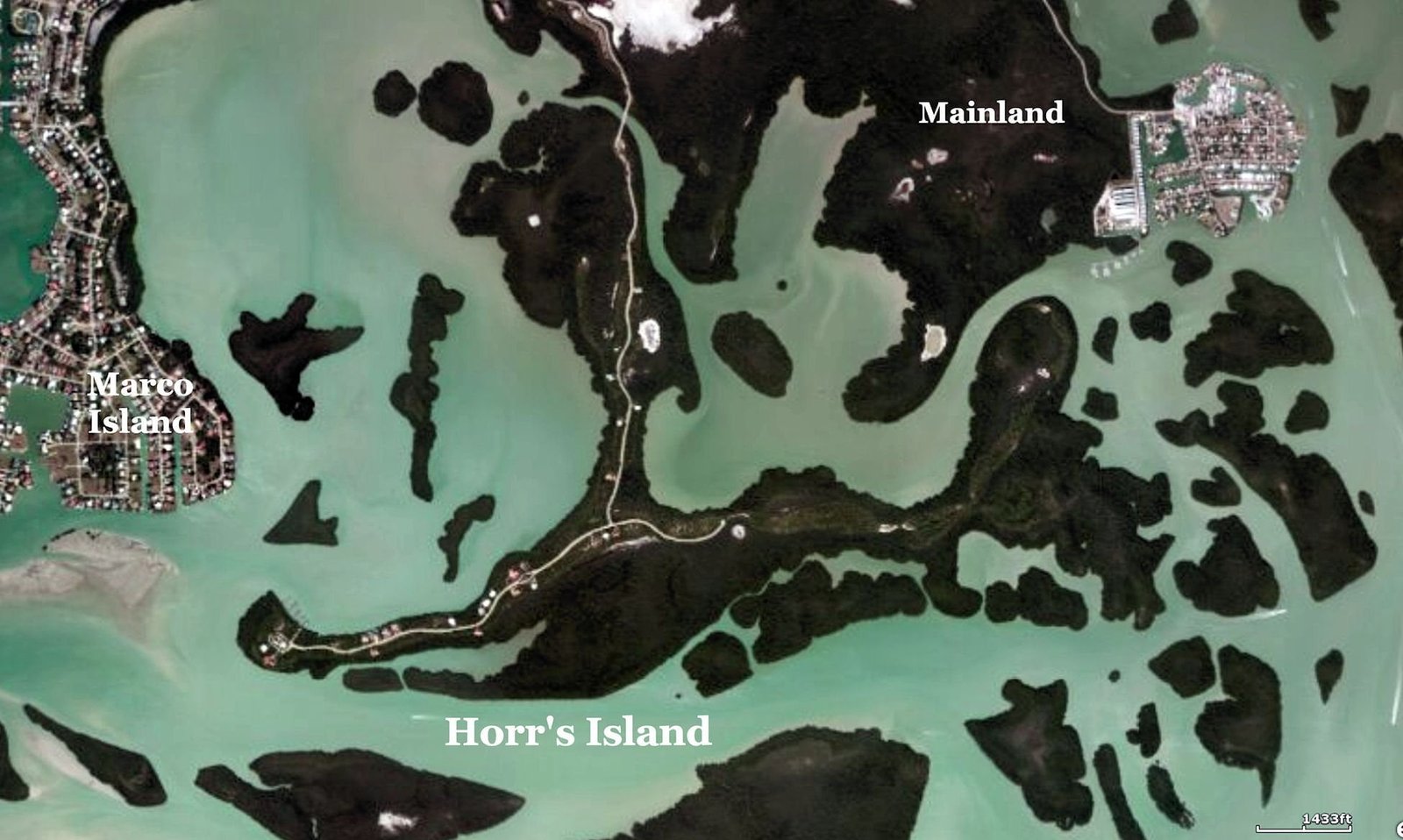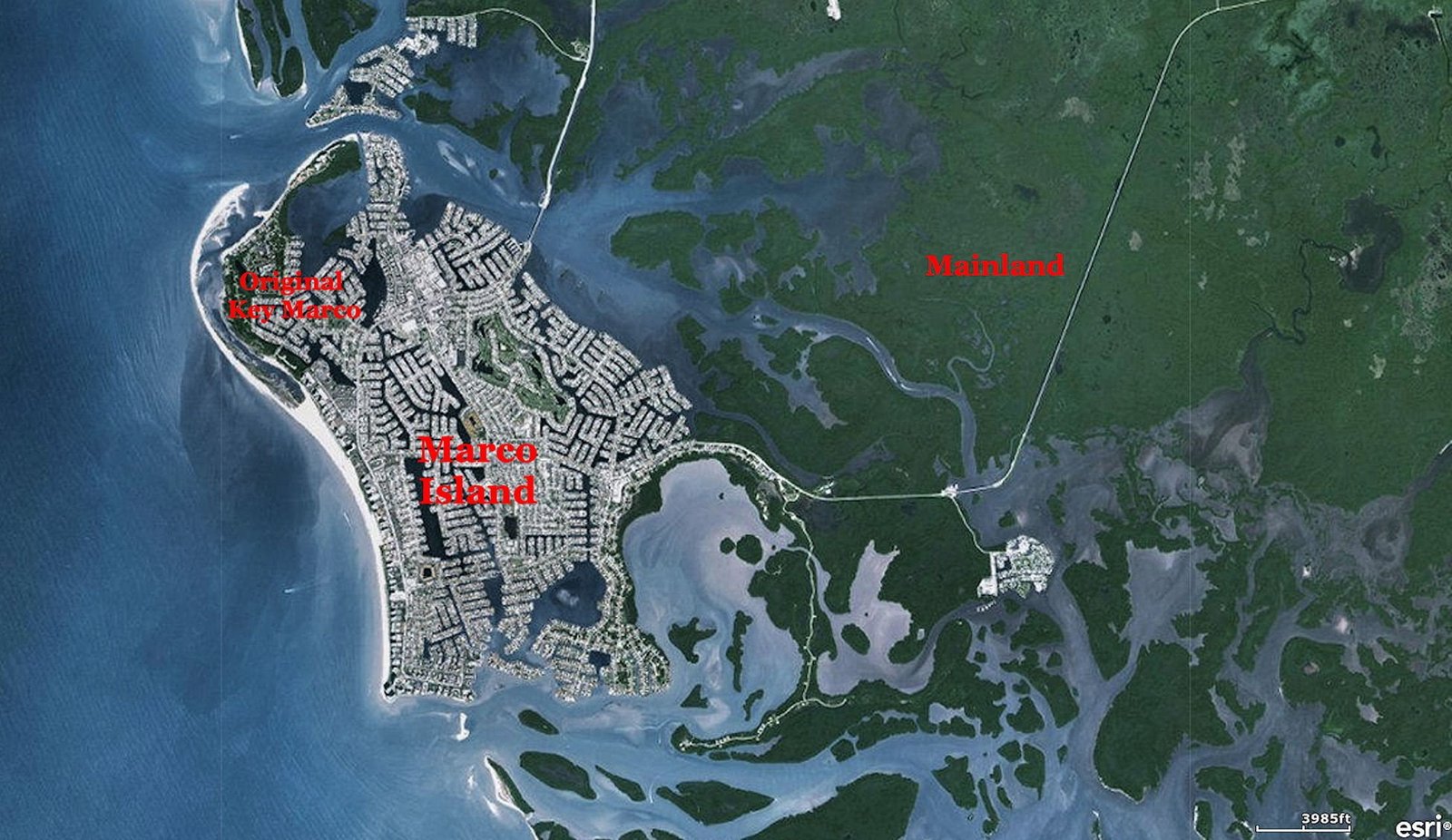A cluster of islands on the Gulf Coast of Florida, immediately south of Naples, FL and southwest of Lake Okeechobee once held numerous mounds and town sites. Know as the Ten Thousand Islands Region, it contains the villages and mounds of an unidentified Archaic Period people, the Muspa Culture and the Calusa People, who absorbed the Muspa. The Muspa or Thousand Islands Culture in recent years has been considered a division of the Lake Okeechobee-Glades Culture. 1
The oldest cluster of shell mounds, on what was formerly called Horr’s Island, date as far back as 4700 BC. 2 Another mound there contains some of the oldest known mound burials (1400 BC) in North America. Horr’s Island was renamed Key Marco by real estate developers, but is not the same Key Marco where a platform village was found. It is located south of Marco Island in Collier County, FL.
Most of the archaeological in the northern portion of the Thousand Islands have been long lost to real estate development. The few sites that have been excavated professionally yielded exquisite wood and shell art. To date, there is has been no explanation why the location became the earliest known location in North America for ceremonial mounds, permanent villages and burial mounds.
Key Marco platform village

Key Marco was a small island adjacent to Marco Island. 3 In the 20th century, the two islands were physically linked together. Later Horr’s Island was purchased by real estate developers and renamed Key Marco. This causes great confusion, so this article will continue to call Key Marco and Horr’s Island by their original names.
Both Marco Island and Key Marco once contained modest shell mounds and middens. However, on Key Marco was a small pond that was the location of a village built on top of a wooden platform, supported by timber posts. It is the only wooden platform village in Florida that has been completely excavated by professional archaeologists. Vestiges of other platform villages have been found along the shore of Lake Okeechobee or smaller lakes. Very little is known about them.
The sophisticated wooden communities represent a unique form of architecture for North America. There were probably many other villages like the one in Key Marco along many of thousands of lakes in Florida and also in the Okefenokee Swamp of Georgia. However, to date, few have been identified.
The Florida Gulf Coast, from Tampa southward was booming in the 1890s. 4 Railroad tycoons and land speculators viewed Florida as one of America’s last frontiers, in which fortunes could be made. In particular, coastal islands could be purchased for cents per acre; connected by bridges and causeways to the mainland, and then converted into real estate holdings worth millions of dollars.
When a real estate developer began grading roads of a planned “upper crust” community on Key Marco Island, his workers immediately began finding many Native American artifacts of exceptional quality. There was very little mechanized road building machinery in that era. Most of the work was done by mules and manual labor. In the 20th century, bulldozer operators would have probably never noticed the artifacts that they were uncovering and therefore, destroyed them.

The developer decided that the Indian artifacts would make an excellent “marketing theme” to attract wealthy Northerners to build winter and retirement homes on the island. He canvassed the country for the best archeologist to retrieve the best artifacts and catalogue them, so they could be placed in a museum on the island. Of particular interest was a marshy area, ill-suited for house construction that appeared to contain several mounds.
The small pond on Key Marco, now known as the “Court of the Pile Dwellers,” (8CR49) was excavated in 1896 by the Smithsonian Institution’s Pepper-Hearst Expedition. 5 Archaeologist Frank Hamilton Cushman supervised the excavation of the mounds, which turned out to be the upper ruins of a platform village. He immediately found hundreds of vertical cypress timbers buried in the muck. There were also thousands of cypress planks and sawed lengths of saplings. The mounds appear to have been below the water surface when built, and were used as anchors for particularly large or tall buildings. The tannic acid in the ground water and lack of oxygen in the muck had preserved the wood structures so that they appeared to be only a few years old.
Cushman was aware that similar type archaeological discoveries in Europe had been interpreted as Neolithic and Bronze Age villages that had sat on timber pilings in lakes. 6 He quickly became convinced that this site was also a timber platform village. At first some local amateur historians interpreted the site as proof than Europeans had built the mounds in the Southeastern United States. However, the abundance of clearly indigenous artifacts that Cushman’s workers uncovered quickly dispelled that myth. American Indians in Florida had indeed built complex wooden structures to support villages in bodies of water.

The quality and quantity of the wooden art astonished archaeologists around the nation. 7 Elsewhere in the Southeast and Midwest, wooden artifacts have quickly turned to humus in their damp resting places. They were no longer recognizable as objects of art. Many simple wooden tool hafts or poles still remained in the ruins of Southwestern Native American settlements, but very few could be labeled “art.” Because Pacific Coast tribes were able to survive the arrival of English-speaking settlers, anthropologists generally acknowledged that they were skilled wood carvers. However, because archaeologists working in the Southeast and Midwest usually only found stone and copper artifacts; they had never really considered the possibility of there being a rich, wood-carving tradition among Indians of the Eastern United States.
Some of the designs and motifs found on the wooden art of Key Marco are similar to copper and stone art found elsewhere in the Southeastern United States. Others are not. The people, who built the platform village at Key Marco were probably not ethnically the same as the Muskogeans (ancestors of the Creeks, Seminoles, Alabamas, Choctaws, etc) who built most of the mounds in the remainder of the Southeast. However, it is very likely that some of the descendants of the Key Marco People joined the Seminole Alliance.
Almost no skeletal remains were found at the Key Marco Site. DNA analysis of bones has only been possible in recent decades, so even if partial skeletons had been found, it would have been difficult to ascertain their ethnic identity. Recent radiocarbon dating of the Key Marco artifacts has placed them mostly between 500 AD and 800 AD. This is a time period in which the Classic Maya Civilization was developing, and Mesoamerican sailors were expanding their trade routes into the entire Caribbean Basin and Gulf of Mexico.
Relationship between other cultural areas in Florida
During the excavation of the Fort Center site, William Sears unearthed numerous examples of wood art that had been preserved by the anaerobic environments of its pools and peat. 8 Sears noticed that the style of the wood art at Fort Center was very similar or identical to that found seven decades earlier on Key Marco. However, at the time most archaeologists labeled all the indigenous cultures of southwest Florida as being Calusa. Therefore, from their perspective, there was not a separate cultural tradition manifested at Fort Center and Key Marco.
Excavations at Mound Key near Fort Myers, Florida in the late 20 th century also identified timber posts that had been the piers for wood platform villages. 9 This seemed to confirm the interpretation of southwest Florida being occupied by the Calusa and being culturally distinct from Lake Okeechobee.
Because villages built on wooden platforms over shallow water have been found in the Thousand Islands region, this form of architecture was thought to be unique to that region of Florida. This architectural tradition seemed to indicate that the people of Lake Okeechobee and the southwest Florida coast were entirely different ethnic groups. Reassessment of other coastal and lake-edge archaeological sites now negate that assumption. They probably spread over a much wider of area of the Southeast; at least in bands.
An especially severe drought in southern Florida during 2006 and 2007 caused the water level to drop lower than it has been in many decades. 10 The exposed lake bed revealed Native American artifacts from thousands of years of history, including hundreds, if not thousands of human skeletons and timber peers that once supported houses or villages like the one found at Key Marco. The oldest skeletons were short and small boned like many tribes of Central America and the Amazon Basin . . . including the Lowland Mayas. The more recent bones were from large humans with massive skulls.
The oldest skeletons were diminutive and linked genetically to the indigenous peoples of Central America or the Amazon River Basin. 11 The upper level contained skeletons were super-sized. They had much large leg and arm bones than average Americans today. Their skulls were massive. Newspaper reporters that read the press release assumed that the diminutive skulls were Mayas. However, at this time the diminutive skeletons have only been linked to a region of the Americas – not a specific ethnic group. 12
Some artifacts were found on the lake bed that showed a direct cultural link between Lake Okeechobee and the Thousand Islands region during the period between around 900 AD and 1150 AD. 13 Newer artifacts showed a strong association with the Calusa Culture. With this information, anthropologists concluded that the people of the Thousand Island Culture were a division of the Glades Culture.
Underwater mounds have been discovered in several locations along the Gulf Coast of Florida. The best documented are on the edge of Perdido Bay next to the Eglin Air Force Base Officers Compound. 14 They appear to also bases for platform villages, but have not been excavated to date, in order to confirm evidence of wooden piers.
Citations:
- MacMahon, Darcie A. and William H. Marquardt (2014). The Calusa and Their Legacy: South Florida People and Their Environments. Gainesville, Florida: University Press of Florida: p. 6.[
]
- Brown, Robin C. (1994). The Late Archaic: Horr’s Island – Florida’s First People. Sarasota, Florida: Pineapple Press. pp. 31-38.[
]
- Widmer, Randolph J.; Frank Hamilton Cushing (2000). “Introduction”. Exploration of Ancient Key-Dweller Remains on the Gulf Coast of Florida. Gainesville, Florida: The University Press of Florida. pp. i-xxii.[
]
- Key Marco, Wikipedia.[
]
- 8CR48 designates the entire Key Marco site, while 8CR49 designates just the pond known at the “Court of the Pile Dwellers” within the Key Marco site. (Widmer:2000:ix).[
]
- Widmer, Randolph J.; Frank Hamilton Cushing (2000). “Introduction”. Exploration of Ancient Key-Dweller Remains on the Gulf Coast of Florida. Gainesville, Florida: The University Press of Florida. pp. i-xxii.[
]
- Widmer, Randolph J.; Frank Hamilton Cushing (2000). “Introduction”. Exploration of Ancient Key-Dweller Remains on the Gulf Coast of Florida. Gainesville, Florida: The University Press of Florida. pp. i-xxii.[
]
- Sears, William (1994) Fort Center, An Archaeological Site in the Lake Okeechobee Basin. Gainesville: Florida University Press: pp. 38-58.[
]
- Widmer, Randolph J.; Frank Hamilton Cushing (2000). “Introduction”. Exploration of Ancient Key-Dweller Remains on the Gulf Coast of Florida. Gainesville, Florida: The University Press of Florida. pp. i-xxii.[
]
- “Drought reveals relics of prehistoric Florida – Artifacts turn up as water recedes in Lake Okeechobee.” June 10, 2007, South Florida Sun-Sentinel.[
]
- “Drought reveals relics of prehistoric Florida – Artifacts turn up as water recedes in Lake Okeechobee.” June 10, 2007, South Florida Sun-Sentinel.[
]
- “Drought reveals relics of prehistoric Florida – Artifacts turn up as water recedes in Lake Okeechobee.” June 10, 2007, South Florida Sun-Sentinel.[
]
- “Drought reveals relics of prehistoric Florida – Artifacts turn up as water recedes in Lake Okeechobee.” June 10, 2007, South Florida Sun-Sentinel.[
]
- The author was preparing measured drawings of the nearby Camp Pinchot buildings for the Historic American Buildings Survey under contract with New South Associates, an Atlanta Area archaeological firm, when its archaeologists discovered the underwater mounds.[
]
